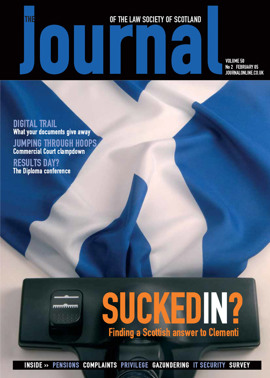Tread carefully

It’s not enough to talk
More about sentencing discounts is to be found in the observations of Lord Penrose in HMA v Booth, a successful Crown appeal against sentence. For our purposes the case is of interest for what the court had to say about the operation of the then applicable legislation, section 196 of the Criminal Procedure (Scotland) Act 1995. It was emphasised that this section is in favour of the accused and depends on certain crucial facts. First, there should have been an unequivocal statement of the accused’s position as regards pleading guilty, regardless of the attitude of the Crown to that proposal. Clearly the earlier this is done, the greater advantage may accrue to the accused. Secondly, of great importance is the correlation between what is offered and the ultimate disposal of the case. Thirdly, consideration has to be given to the circumstances in which the plea was offered; in particular the position of the co-accused cannot be used to justify delay in making a proposal. Accordingly, it is clear that agents must now take a decision as early as possible about what they will, without equivocation, be prepared to plead to on behalf of their client This should be communicated without delay. That the Crown does not immediately accept does not matter. The days of negotiating pleas by way of tentative offers made informally to the Crown are definitely over if the maximum advantage in discount is to be achieved: talking to the Crown is simply not enough. Incidentally, Mackie v Ward, referred to in the December article, is now at 2004 GWD 37-762.
The uncertainty of contempt
One area in which it might be as well to tread carefully is that of contempt of court. Put broadly, the arrival of ECHR, associated with the somewhat unusual (putting it mildly) case of Kyprianou v Cyprus, ECtHR, 27 January 2004, unreported, has meant that doubt has been expressed about the traditional methods of dealing with contempt. In particular, on an analysis which seems to identify the presiding judge as the complainer, it has been suggested that there is a bit of the auctor in rem suam about that person first deciding as a matter of fact that there has been contempt, and secondly, proceeding to impose a penalty. One of the troubles is that contempt can come in so many different forms, although it is probable that a similar mens rea is required. Be that as it may, some idea of the prevailing situation can be got from a study of Mayer v HMA 2004 GWD 37-761, although it is unfortunate for present purposes that that case is also highly unusual, involving (like Kyprianou) an allegation of contempt of a court by someone practising before it. This was recognised by the appeal court, which put the case out by order for a hearing to discuss appropriate further procedure. What concerns us here most closely is the observation of the appeal court that, because difficult and novel questions were raised which were important to the administration of justice, there was a temptation to convene a larger court to obtain an authoritative ruling. However it was recognised that, given the wide scope and varied nature of possible contempt under Scots law, it was not likely that in the present case a comprehensive solution could be achieved. Accordingly it seems that if the law of contempt is to be considered by a larger court in the light of the Convention and European jurisprudence, this will have to be done in a case more typical of the normal contempt. This is in line with the philosophy of our appeal procedure, which first and foremost gives answers in a particular case, albeit the reasons therefor may be susceptible of a wider application.
A useful provision?
Prosecutions under the Criminal Law (Consolidation) (Scotland) Act 1995, section 50A(1)(b) do not appear to be diminishing. Although there was considerable doubt as to the wisdom of this enactment, it being regarded in some quarters as at best useless and at worst counter-productive, we have it, it is in use and we will have to think about it. The charge is one of acting in a racially aggravated manner causing or intending to cause alarm or distress. (It should be noted that in terms of paragraph 14(b) of schedule 3 to the 1995 Act it is competent for the court, if asked, to substitute a conviction for breach of the peace and this may be done if the facts justify it.) The whole matter came before the appeal court in Anderson v Griffiths 2004 GWD 38-778, where the locus was a football match. The difficulty for the Crown, which it conceded, was that while the sheriff had found that two spectators had been upset and disgusted by the words used by the appellant, it had not been found as a matter of fact that the words used were intended to cause alarm or distress to the complainers (football players), it having been found in fact that the words complained of were actually inaudible on the field. As a matter of law the Crown accepted at the hearing of the appeal that the alarm or distress had to be that of the intended victim, and actual distress to a bystander was not sufficient. It is not clear why the Crown had not proposed an adjustment to the draft stated case to deal with this difficulty. In the event the appeal court did substitute a conviction for breach of the peace. All of this may go to show that the doubters may well have been right, unless you think that the criminal law is strengthened by being made more complicated.
Penalties fixed and weighted
On the road traffic front there is an interesting short case. Bryson v Currie 2004 GWD 39-787 concerned a motorist who was offered a fixed penalty of £60 for speeding but was unable to take it up as his licence was already at the DVLA for another reason under the same statutory code. His appeal against a fine of £100 was successful, it being held that it would not be fair to penalise him beyond the terms of the fixed penalty notice. It does not, however, seem to be suggested that a fine of £100 for doing 56mph in a 40mph limit area is excessive, which makes one think that there may be something a bit odd about fixed penalties. One hopes that if these are to be extended into other areas, they are not routinely set at a level so low as to attract acceptance due to that very fact.
McLellan v Reith 2004 GWD 37-772 is an appeal against the imposition of a period of two years’ disqualification of a first offender for failing without reasonable excuse to provide two breath specimens. It appears that the sentencing sheriff took into account a substantial increase in analogous offences by people over the past two years and concluded that a lesser penalty would be inadequate. What is perhaps of interest is that the appeal court confirmed that a sheriff is fully entitled to take into account the prevalence of a particular offence in his or her area and to adjust the penalty in respect thereof. It was emphasised however that this did not diminish the need to take into account the circumstances of a particular offence and of a particular offender. I am not sure where this leaves us really. In the instant case the period of disqualification was reduced to 15 months, which reading the report as a whole seems to suggest that that appeal court allowed a general “weighting” for local frequency of three months.
Wild and woolly
This is not really the place to criticise new legislation, but it can safely be said that regardless of the merits of what it is trying to achieve, the Protection of Wild Mammals (Scotland) Act 2002 has not attracted many admirers for the excellence of its drafting. The Act came under judicial scrutiny in Fraser v Adams 2005 GWD 1-8. It is discouraging, I think, to find that the court was already faced with legitimate difficulties in working out what certain sections of the Act really meant. Still in the world of wildlife, but perhaps with more general application is Kennedy v Laing 2005 GWD 1-10 in which suspension was sought of a warrant granted by a sheriff under the Wildlife and Countryside Act 1981, section 19(3). It was argued that the sheriff who granted it had not been informed by the Crown that the information on which the warrant had been applied for had been obtained illegally, inasmuch as the people who saw the trap that was the subject of the prosecution were said to be on the land without the permission of the proprietor and thus in contravention of that person’s right to privacy under article 8 of the Convention. The appeal court felt that it was doubtful if open moorland could be characterised as a ”home”, and in the whole matter the appeal was treated, perhaps not surprisingly, as misconceived.
In this issue
- Sell or transfer? (1)
- Promoting competition or competitiveness?
- Promoting competitiveness or competition?
- Not the final word
- Challenge of the FSA
- The pull of the south
- A world of change
- Finding the path
- An elusive model?
- Bank on it
- Trouble at t'mill
- Hidden evidence
- Money claims on behalf of children
- Secure connections
- Tread carefully
- Sell or transfer?
- Cracking the conflict code
- X Factor for success?
- Scottish Solicitors' Discipline Tribunal
- Website reviews
- Book reviews
- Is "gazundering" always bad?
- Defining the guideline






